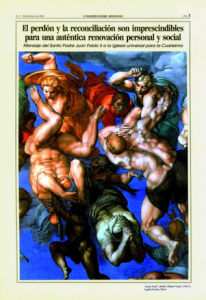
Since 2013, Pope Francis I has been making unexpected comments about homosexuality, which usually call for compassion and tolerance. While these speech acts erupt here and there, the flow of water to the mill of Catholic conservatism follows its course.[1]
A few months after his election and subsequently to World Youth Day in Rio de Janeiro, the first global event he attended after taking the post, Bergoglio made an apparently unprecedented statement about homosexuality, the content of which contrasted with the condemnatory tone typical of his predecessor. On the flight back to Rome, the Pope told journalists traveling on the same plane: “If a person is gay, seeks God and has goodwill, who am I to judge them?”.
This apparently innovative position, in fact, does not contradict the doctrinal position of the church, according to which homosexual desires exist (as any other sin) and the subject who experiences them should be the object of compassion. This does not mean, however, that the practice is not to be condemned as a serious sin. But, as it would happen countless times since then, the media furor caused by the declaration obliterated its alignment with the doctrine and has also evacuated the subsequent enigmatic phrase in which Francis vigorously abhorred the “gay lobby” equated by him with the “Masonic lobby”.
Three years later, in 2016, in the Encyclical Amoris Laetitia, Francis once again recommended a compassionate approach to the homosexual faithful: “Each person, regardless of their sexual orientation, should be respected in their dignity and welcomed with respect“. But, as Kaoma (2018) points out, this same papal exhortation calling for the joy of love and reaffirming the tolerance announced in 2013, restricts love and the right to form a family to heterosexual couples, in the following terms:
The right to form a family is a right that is not restricted to the homosexual… de facto same-sex partnerships cannot simply be equated with marriage. No temporary union or one that is closed to the transmission of life can ensure the future of society.
Then, in 2019, the Holy See published the guideline entitled Male and Female, He created them – Towards a path of dialogue on the question of gender theory in education, the very first official document of Francisco papacy on the “trouble of gender”. Though the publication did not provoke the media flares usually sparked by papal speech acts, it is a very important document. Its tone differs from the accusatory rhetoric of earlier papal documents on the matter. It is framed as an invitation to educators to engage in a constructive dialogue about the “meanings of gender”. However, this soft tone does not imply a meaningful doctrinal inflection. The document not only reiterates the dogmatic conceptions about natural sexual difference inscribed in the voluminous theological production on gender of the early 2000s, but also rejects the “intersex” and “transgender” categories. In other words, the rhetoric of Francis papacy with regards to the “trouble of gender” is innovative only on its surface (read Mary Anne Case’s analysis).
At around the same time, the Vatican Secretary of State, Cardinal Parolin, received a group of 51 LGBTTI activists – including some transgender people – for a dialogue on non-discrimination. The event did not have either wide media visibility, but it caused much enthusiasm in activist circles. Then in 2020, already during COVID 19, another episode would have a much bigger repercussion, when the Vatican charity arm has taken food to homeless and jobless trans people.
But then, right before the most recent papal speech on civil unions between same-sex persons, the Vatican published – again without greater public repercussion beyond the Catholic camp – a new Catechesis Directory that, as in the case of the 2019 document on gender and education, reaffirms the same arguments that for quite a time has been feeding the scarecrow of “gender ideology”. In this text, the critique of the right to gender identity is particularly striking:
“According to this position, gender identity would no longer be that original identity that a person must accept and fill with meaning, but rather a social construction decided autonomously, completely dissociated from biological sex. Man denies his own nature and decides to create one for himself. However, according to the biblical account of creation, the human being was created by God as man and woman”.
This brief review, although not exhaustive, confirms Maximo Prearo’s recommendation that papal speech acts and gestures should not be interpreted, much less celebrated, as singular facts full of meaning in themselves. They must always be read with great caution as pieces of a vast and complex institutional, political and discursive puzzle, whose signs are more than often contradictory.
Given that, we offer our readers a retrospective of selected materials on Bergoglio’s speeches and gestures on sexual matters that have been published on SPW’s website since 2013.
Bibliographic reference: Kapia Kaoma, The Vatican anti-gender theory and sexual politics: An African Response. In David Paternotte and Sara Bracke “Habemus Gender! Gender and Religion. Vol. 6, no. 2 (2016), 282-292
Image: Léon Ferrari, from the series ‘Osservatore Romano, Malba Collection
